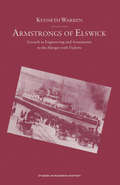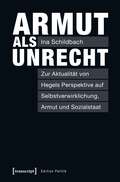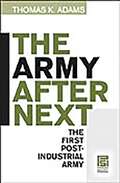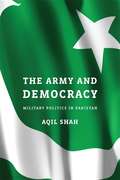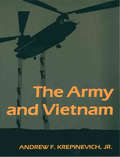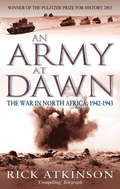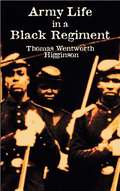- Table View
- List View
Arms Transfers to Israel: The Strategic Logic Behind American Military Assistance
by David RodmanThis book dispels two common myths about the American-Israeli patron-client relationship -- that arms transfers to Israel have been motivated by American domestic politics rather than national interests and that these arms transfers have come without any political strings attached to them. The first part of the book describes and analyses the institutionalisation of the American-Israeli arms pipeline during the Johnson administration, demonstrating conclusively in the process that arms transfers to the Jewish state were based primarily on American national interests. The second part of the book consists of four case studies that clearly reveal that American arms transfers to Israel, whether in wartime or in peacetime, have always come with a diplomatic price tag attached to them. The book is based largely on American government documents from the Foreign Relations of the United States (FRUS) series, from the Lyndon B Johnson Presidential Library, and from the United States National Archives.
Armstrongs of Elswick: Growth In Engineering And Armaments To The Merger With Vickers (Studies in Business History)
by Kenneth WarrenArmstrong, the engineers, armament makers and naval shipbuilders was set up in 1847 by William Armstrong at Elswick, Newcastle-Upon-Tyne. This book analyzes Armstrong's 80 years rise, decline and reorganization, treating it, in some ways, as a case study of British industrial malaise.
Armut als Unrecht: Zur Aktualität von Hegels Perspektive auf Selbstverwirklichung, Armut und Sozialstaat (Edition Politik #63)
by Ina SchildbachSeit den Anfängen der bürgerlichen Gesellschaft gibt es »künstlich produzierte Armut« (Marx) - künstlich, weil sie, wie Hegel analysiert hat, nicht auf natürlichem Mangel beruht, sondern ihre Notwendigkeit im Recht auf Eigentum liegt. Auch wusste der Philosoph: Ohne materielle Mittel gibt es keine Selbstverwirklichung. Die von Hegel theoretisch vorweggenommenen Konsequenzen wie der Zusammenhang mit geringerer Bildung, kürzerer Lebenserwartung und politischer Apathie sind heutzutage empirisch belegt. Ina Schildbach liest Hegel neu und stellt fest: Erkenntnisbringend sind nicht nur seine Einsichten zu Ursachen und Konsequenzen der Armut - auch die staatsfunktionale Perspektive auf Armut als Problem der Obrigkeit offenbart frappierende Ähnlichkeit zum heutigen Diskurs.
The Army after Next: The First Postindustrial Army (Praeger Security International)
by Thomas K. AdamsThis book recounts the successes and failures of the US Army's Army Transformation program in the larger context of the Department of Defense's overall military transformation effort.Spurred by the belief that RMA represented the future, the Department of Defense (DoD) set out to transform the U.S. armed forces by adopting RMA concepts. Led by President George W. Bush and Defense Secretary Donald Rumsfeld, the DoD spent billions in an attempt to make the hypothetical capabilities real, changing the entire structure of the armed forces as a result. The services, the media, Congress, and the military industry each had its own agenda, all of which continue to come into play in the development of RMA strategies. The interplay of politics, technology, and military reality offers a fascinating narrative.Sure to be found controversial by some, compelling by all, this is the only available book-length examination of the way the U.S. Army and Department of Defense have tried to create the capabilities promised by the high-tech Revolution in Military Affairs. Of more immediate concern, it is also the only in-depth account of the effect RMA and transformation concepts had on the American operations in Afghanistan and Iraq. Many of the problems in both Iraq and Afghanistan, author Thomas K. Adams argues, arose from the DoD's implacable desire to implement RMA-driven transformation concepts—whether they were appropriate or not. What we need to do, he maintains, is to fight the war we have, not the war we want.
The Army and Democracy: Military Politics In Pakistan
by Aqil ShahIn sharp contrast to neighboring India, the Muslim nation of Pakistan has been ruled by its military for over three decades. The Army and Democracy identifies steps for reforming Pakistan's armed forces and reducing its interference in politics, and sees lessons for fragile democracies striving to bring the military under civilian control.
The Army and Democracy: Military Politics In Pakistan
by Aqil ShahIn sharp contrast to neighboring India, the Muslim nation of Pakistan has been ruled by its military for over three decades. The Army and Democracy identifies steps for reforming Pakistan's armed forces and reducing its interference in politics, and sees lessons for fragile democracies striving to bring the military under civilian control.
Army and Nation: The Military and Indian Democracy since Independence
by Steven I. WilkinsonSteven I. Wilkinson explores how India has succeeded in keeping the military out of politics, when so many other countries have failed. He uncovers the command and control strategies, the careful ethnic balancing, and the political, foreign policy, and strategic decisions that have made the army safe for Indian democracy.
Army and Nation: The Military and Indian Democracy since Independence
by Steven I. WilkinsonSteven I. Wilkinson explores how India has succeeded in keeping the military out of politics, when so many other countries have failed. He uncovers the command and control strategies, the careful ethnic balancing, and the political, foreign policy, and strategic decisions that have made the army safe for Indian democracy.
Army and State in Postcommunist Europe
by David Betz John LowenhardtThis study explores the complex military issues that are raised by the transition to post-communist rule with particular reference to Russia, Ukraine, Bulgaria, and the new members of NATO. All faced similar problems yet their responses, it emerges, were surprisingly diverse.
Army and State in Postcommunist Europe
by David Betz John LöwenhardtThis study explores the complex military issues that are raised by the transition to post-communist rule with particular reference to Russia, Ukraine, Bulgaria, and the new members of NATO. All faced similar problems yet their responses, it emerges, were surprisingly diverse.
The Army and the Radical Left in Turkey: Military Coups, Socialist Revolution and Kemalism (Library Of Modern Middle East Studies)
by Özgür Mutlu UlusIn 1960s Turkey, the armed forces and the radical leftist movement provided two very dynamic, but very different, political forces. Yet, somewhat surprisingly, the majority of radical leftists in this period believed in the revolutionary potential of the armed forces in overthrowing the existing regime and replacing it with a quasi-socialist one. Covering the time between the two successful military interventions of 1960 and 1971, The Army and the Radical Left in Turkey considers the changing perspectives of the radical leftist movement towards the political role of the military in Turkey in this period.The democratic reforms which followed the 1960 coup allowed leftist groups to operate legally for the first time, and as a result, Marxist or quasi-Marxist groups expanded and diversified enormously in the years that followed. But one of the significant problems faced by the leftist movement in the 1960s was factionalisation and the issue of why the left could not maintain unity in Turkey during this period. Ulus argues here that differing and opposing attitudes towards the armed forces within the leftist movement was one of the key causes of factionalisation – and that these differences became even more noticeable towards the end of the 1960s. Examining the development of the leftist movement, its understanding of Kemalism, as well as the discourses and actions of the different leftist groups, including the Communist Party of Turkey and the Workers' Party of Turkey, Ulus analyses the political thought and organisational structures of these groups. She thereby shows why some leftists chose to encourage a military revolution, which they hoped would bring about the triumph of socialism in Turkey, but instead led to their downfall. As the 1960s ended with the radical left in disarray, this book will be invaluable for researches of the parties of the left across the Middle East, as well as scholars of modern Turkish history and politics.
The Army and Vietnam
by Andrew F. Krepinevich Jr.Many senior army officials still claim that if they had been given enough soldiers and weapons, the United States could have won the war in Vietnam. In this probing analysis of U.S. military policy in Vietnam, career army officer and strategist Andrew F. Krepinevich, Jr., argues that precisely because of this mindset the war was lost before it was fought.The army assumed that it could transplant to Indochina the operational methods that had been successful in the European battle theaters of World War II, an approach that proved ill-suited to the way the Vietnamese Communist forces fought. Theirs was a war of insurgency, and counterinsurgency, Krepinevich contends, requires light infantry formations, firepower restraint, and the resolution of political and social problems within the nation. To the very end, top military commanders refused to recognize this.Krepinevich documents the deep division not only between the American military and civilian leaders over the very nature of the war, but also within the U.S. Army itself. Through extensive research in declassified material and interviews with officers and men with battlefield experience, he shows that those engaged in the combat understood early on that they were involved in a different kind of conflict. Their reports and urgings were discounted by the generals, who pressed on with a conventional war that brought devastation but little success.A thorough analysis of the U.S. Army's role in the Vietnam War, The Army and Vietnam demonstrates with chilling persuasiveness the ways in which the army was unprepared to fight—lessons applicable to today's wars in Afghanistan and Iraq.
An Army At Dawn: The War in North Africa, 1942-1943 (Liberation Trilogy #Vol. 1)
by Rick AtkinsonThe liberation of Europe and the destruction of the Third Reich is a story of courage and enduring triumph, of calamity and miscalculation. In this first volume of the Liberation Trilogy, Rick Atkinson shows why no modern reader can understand the ultimate victory of the Allied powers without a grasp of the great drama that unfolded in North Africa in 1942 and 1943.Beginning with the daring amphibious invasion in November 1942, An Army at Dawn follows the British and American armies as they fight the French in Morocco and Algeria, and then take on the Germans and Italians in Tunisia. Battle by battle, an inexperienced and sometimes poorly led army gradually becomes a superb fighting force. Central to the tale are the extraordinary but fallible commanders who come to dominate the battlefield: Eisenhower, Patton, Bradley, Montgomery and Rommel.
Army, Empire and Politics in Meiji Japan: The Three Careers of General Katsura Tar?
by S. LoneDramatic innovations in modern Japan include a mass army, overseas empire, and constitutional polity. This is the first book to link these changes in the Meiji era (1868-1912). It focuses on the life of General Katsura Taro, one of the architects of the modern military, a leading figure in Japanese colonialism, and prime minister through the 1900s. Challenging the received wisdom about Japanese militarism and imperialism, it exposes the army's ambivalence about empire but also its positive role in political change.
Army Girls: The secrets and stories of military service from the final few women who fought in World War II
by Tessa DunlopArmy Girls is the intimate story of the final few women who served in World War II and are still alive to tell their tale. They were female soldiers in a war Britain wanted to fight without conscripting women. It was a vain hope, by December 1941 for the first time in British history women were called up and a generation of girls came of age in khaki, serving king and country. Barbara trained to drive army-style in giant trucks and Grace swapped her servant's pinafore for battledress and a steel hat, Martha turned down officer status for action on a gun-site and Olivia won the Croix de Guerre in France.Commemorating the 80th anniversary of conscription for women, Army Girls captures remarkable stories from the last surviving veterans who served in Britain's female army and brings to life a pivotal moment in British history. Precious memories and letters are entwined in a rich narrative that travels back in time and sheds new light on being young, female and at war.Uniquely this moving Second World War memoir is embedded in the present day. Written in the midst of a global pandemic, the parallels and paradoxes between two very different national crises are explored in a book that honours the women who fought on in extreme youth and now once more in great old age.
The Army in British India: From Colonial Warfare to Total War 1857 - 1947 (Bloomsbury Studies in Military History)
by Kaushik RoyThe army in India was the principal pillar of British power in South Asia from the mid-nineteenth century until Indian independence. This volume aims to evaluate the combat effectiveness of the army in British India from the mutiny of 1857 until the British departed India in 1947. It examines how the army in India developed from a colonial police force into one of the world's largest volunteer armies which saw service around the globe. The author presents new primary material from international archival sources and develops original interpretations of the political and military role of the army in colonial India. These new arguments include: the army's conduct of 'small wars' on the North-West frontier aided it in conducting tactical warfare in Burma during World War II; small unit raids developed in India were put to good effect beyond India's borders; the army's practical experience of counter-insurgency was used in Greece and Indonesia after 1945; and, contrary to existing scholarship, the British did not follow a deliberate policy of 'Indianization' of the officer corps .
The Army in British India: From Colonial Warfare to Total War 1857 - 1947 (Bloomsbury Studies in Military History)
by Kaushik RoyThe army in India was the principal pillar of British power in South Asia from the mid-nineteenth century until Indian independence. This volume aims to evaluate the combat effectiveness of the army in British India from the mutiny of 1857 until the British departed India in 1947. It examines how the army in India developed from a colonial police force into one of the world's largest volunteer armies which saw service around the globe. The author presents new primary material from international archival sources and develops original interpretations of the political and military role of the army in colonial India. These new arguments include: the army's conduct of 'small wars' on the North-West frontier aided it in conducting tactical warfare in Burma during World War II; small unit raids developed in India were put to good effect beyond India's borders; the army's practical experience of counter-insurgency was used in Greece and Indonesia after 1945; and, contrary to existing scholarship, the British did not follow a deliberate policy of 'Indianization' of the officer corps .
The Army in India and the Development of Frontier Warfare, 1849-1947 (Studies in Military and Strategic History)
by T. MoremanThis comprehensive study is the first scholarly account explaining how the British and Indian armies adapted to the peculiar demands of fighting an irregular tribal opponent in the mountainous no-man's-land between India and Afghanistan. It does so by discussing how a tactical doctrine of frontier fighting was developed and 'passed on' to succeeding generations of soldiers. As this book conclusively demonstrates this form of colonial warfare always exerted a powerful influence on the organisation, equipment, training and ethos of the Army in India.
The Army in the Roman Revolution
by Arthur KeaveneyThe Roman Revolution is one of the most momentous periods of change in history, in which an imperial but quasidemocratic power changed into an autocracy. This book studies the way the Roman army changed in the last eighty years of the Republic, so that an army of imperial conquest became transformed into a set of rival personal armies under the control of the triumvirs. It emphasizes the development of what has often been regarded as a static monolithic institution, and its centrality to political change.
The Army in the Roman Revolution
by Arthur KeaveneyThe Roman Revolution is one of the most momentous periods of change in history, in which an imperial but quasidemocratic power changed into an autocracy. This book studies the way the Roman army changed in the last eighty years of the Republic, so that an army of imperial conquest became transformed into a set of rival personal armies under the control of the triumvirs. It emphasizes the development of what has often been regarded as a static monolithic institution, and its centrality to political change.
Army, Industry and Labour in Germany, 1914-1918
by Gerald FeldmanThis innovative study by one of the leading specialists in the field examines the social and economic role of the German army in the nation's internal affairs during the First World War. This was the area in which the influence of the army was most direct and profound. Germany's wartime economic mobilisation was both planned and directed by the army, and as a consequence of this largely unanticipated responsibility, the army was compelled to cope with the great social conflicts of Imperial Germany. In the process of confronting the groups representing army and labour, the army paved the way for the establishment of collective bargaining in Germany and also created the foundations for the postwar inflation.
Army, Industry and Labour in Germany, 1914-1918 (Legacy Of The Great War Ser.)
by Gerald FeldmanThis innovative study by one of the leading specialists in the field examines the social and economic role of the German army in the nation's internal affairs during the First World War. This was the area in which the influence of the army was most direct and profound. Germany's wartime economic mobilisation was both planned and directed by the army, and as a consequence of this largely unanticipated responsibility, the army was compelled to cope with the great social conflicts of Imperial Germany. In the process of confronting the groups representing army and labour, the army paved the way for the establishment of collective bargaining in Germany and also created the foundations for the postwar inflation.
'The Army Isn't All Work': Physical Culture and the Evolution of the British Army, 1860–1920
by James D. CampbellBetween the Crimean War and the end of the First World War the British Army underwent a dramatic change from being an anachronistic and frequently ineffective organization to being perhaps the most professional and highly trained army in the world. Historians have tended to view that transformation through the successive political reform efforts of those years, but have largely overlooked the ways in which the Army transformed itself from within. This change was effected through the modernization of training, operational and leadership doctrines. The adoption of formal physical training and organized games played a central part in this process. With its origins in elite public schools and upper-class country homes, the Army's philosophy of Athleticism was a part of the ethos of 'muscular Christianity' widely held in contemporary British institutions. Under the potent influence of this philosophy, military sport went from a means of keeping soldiers from drink and the officers from duty, to an institutionalized form of combat training. This book documents the origins and development of formal physical training in the late Victorian Army and the ways in which the Army's gymnastic training evolved into a vital building block of the process of turning a civilian into a fighting man. It also assesses the nature and extent of British military sport, particularly regimental sports, during this period of evolution for the Army. Through an investigation of the Army's physical culture during this dynamic period, one can gain an understanding of not only how the Army's change from within occurred, but also of some of the important links between the Army and its parent society.
'The Army Isn't All Work': Physical Culture and the Evolution of the British Army, 1860–1920
by James D. CampbellBetween the Crimean War and the end of the First World War the British Army underwent a dramatic change from being an anachronistic and frequently ineffective organization to being perhaps the most professional and highly trained army in the world. Historians have tended to view that transformation through the successive political reform efforts of those years, but have largely overlooked the ways in which the Army transformed itself from within. This change was effected through the modernization of training, operational and leadership doctrines. The adoption of formal physical training and organized games played a central part in this process. With its origins in elite public schools and upper-class country homes, the Army's philosophy of Athleticism was a part of the ethos of 'muscular Christianity' widely held in contemporary British institutions. Under the potent influence of this philosophy, military sport went from a means of keeping soldiers from drink and the officers from duty, to an institutionalized form of combat training. This book documents the origins and development of formal physical training in the late Victorian Army and the ways in which the Army's gymnastic training evolved into a vital building block of the process of turning a civilian into a fighting man. It also assesses the nature and extent of British military sport, particularly regimental sports, during this period of evolution for the Army. Through an investigation of the Army's physical culture during this dynamic period, one can gain an understanding of not only how the Army's change from within occurred, but also of some of the important links between the Army and its parent society.
Army Life in a Black Regiment (Civil War)
by Thomas Wentworth Higginson"Army Life in a Black Regiment has some claim to be the best written narrative to come from the Union [side] during the Civil War. Higginson's picture of the battle which was the origin of "praise the Lord and pass the ammunition" and his reading of the Emancipation Proclamation to the black regiment are unsurpassed for eloquence." — historian Henry Steele CommagerOriginally a series of essays, this important volume was written by a Union colonel from New England, in charge of African-American troops training on the Sea Islands off the coast of the Carolinas. A lively and detailed wartime diary, the book offers a refreshing portrait of life in the Union Army from an officer's point of view, recording opinions of other commanders and capturing the raw humor that develops among the men in combat. Higginson's descriptions of the soldiers, routines of camp life, and southern landscapes are unforgettable, as is the account of his near escape from a cannon ball. An unusual historical document intended to introduce new generations of readers to an American past that should not be forgotten, Army Life in a Black Regiment will be invaluable to students of Black History and the American Civil War.

